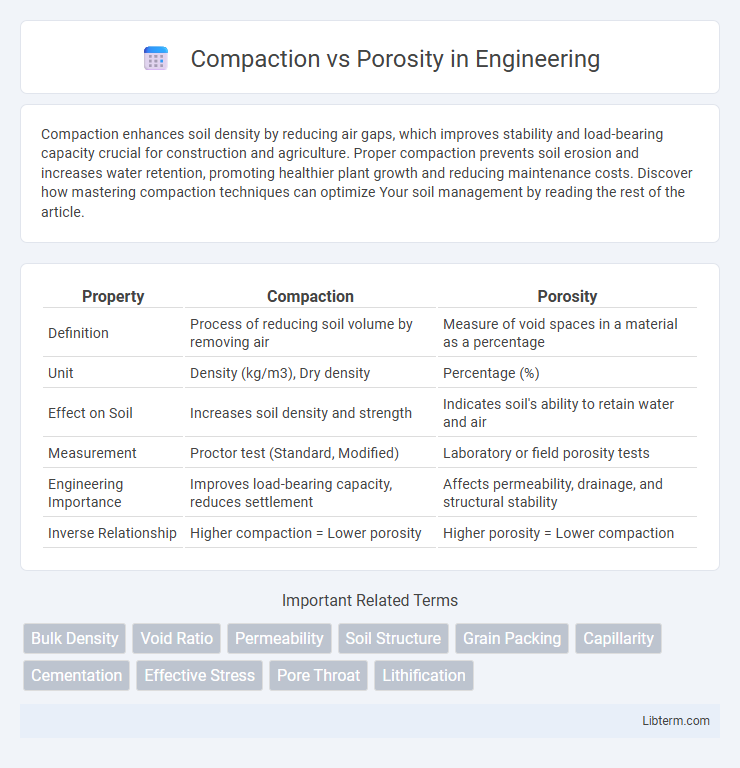Compaction enhances soil density by reducing air gaps, which improves stability and load-bearing capacity crucial for construction and agriculture. Proper compaction prevents soil erosion and increases water retention, promoting healthier plant growth and reducing maintenance costs. Discover how mastering compaction techniques can optimize Your soil management by reading the rest of the article.
Table of Comparison
| Property | Compaction | Porosity |
|---|---|---|
| Definition | Process of reducing soil volume by removing air | Measure of void spaces in a material as a percentage |
| Unit | Density (kg/m3), Dry density | Percentage (%) |
| Effect on Soil | Increases soil density and strength | Indicates soil's ability to retain water and air |
| Measurement | Proctor test (Standard, Modified) | Laboratory or field porosity tests |
| Engineering Importance | Improves load-bearing capacity, reduces settlement | Affects permeability, drainage, and structural stability |
| Inverse Relationship | Higher compaction = Lower porosity | Higher porosity = Lower compaction |
Understanding Soil Compaction
Soil compaction reduces pore space by pressing soil particles closer together, significantly decreasing soil porosity and limiting air and water movement. This process impacts root growth and soil fertility by restricting the availability of essential nutrients and oxygen. Understanding soil compaction is crucial for effective land management and improving crop productivity.
What Is Soil Porosity?
Soil porosity refers to the percentage of void spaces or pores within a soil's total volume, which directly affects its ability to retain water and air essential for plant roots and microbial activity. Compaction decreases soil porosity by compressing these pores, reducing water infiltration, gas exchange, and root growth. Understanding the balance between soil porosity and compaction is crucial for maintaining soil health and optimizing agricultural productivity.
Key Differences Between Compaction and Porosity
Compaction refers to the process that decreases the volume of pore spaces in soil or rock by applying pressure, resulting in a reduction in porosity. Porosity represents the percentage of void spaces within a material that can hold fluids or gases, directly impacting permeability and storage capacity. The key difference lies in compaction as an active process altering soil or rock structure, while porosity is a static measurement of the existing void fraction.
Factors Influencing Soil Compaction
Soil compaction significantly reduces porosity by compressing soil particles closer together, which decreases pore space and limits water infiltration and root growth. Key factors influencing soil compaction include soil texture, moisture content, organic matter, and the intensity and duration of applied pressure from machinery or foot traffic. Fine-textured soils with moderate moisture and low organic content are more prone to compaction due to their smaller particle sizes and reduced aggregate stability.
Elements Affecting Soil Porosity
Soil porosity is primarily influenced by particle size distribution, with finer particles like clay increasing total porosity but reducing permeability compared to coarser particles such as sand. Compaction decreases soil porosity by rearranging particles closer together, reducing pore space and hindering water infiltration and root growth. Factors such as soil texture, organic matter content, and moisture levels also critically affect soil porosity by altering the soil structure and pore connectivity.
Effects of Compaction on Soil Structure
Compaction significantly reduces soil porosity by decreasing the volume of air-filled pores, which negatively impacts water infiltration and root penetration. Soil particles become densely packed, leading to a more rigid structure that limits microbial activity and nutrient cycling. Reduced porosity from compaction also increases surface runoff and erosion risks, impairing overall soil health and plant growth.
Porosity’s Role in Water and Air Movement
Porosity directly influences the movement and retention of water and air within soil, as larger pore spaces facilitate better airflow and water infiltration. High porosity allows efficient drainage and oxygen availability essential for root respiration and microbial activity, whereas low porosity due to compaction restricts these processes. The balance between pore volume and soil particle arrangement determines the soil's capacity to support healthy plant growth by regulating moisture and aeration.
Methods to Measure Compaction and Porosity
Compaction and porosity are critical soil properties measured using methods such as bulk density tests and nuclear density gauges for compaction, and mercury intrusion porosimetry or gas pycnometry for porosity assessment. Compaction measurement techniques focus on evaluating soil particle arrangement and void reduction, while porosity measurement methods quantify the volume of pore spaces within the soil matrix. Accurate determination of these parameters is essential for applications in geotechnical engineering, agriculture, and environmental science.
Best Practices for Managing Soil Health
Effective soil health management requires balancing compaction and porosity to optimize water infiltration, root growth, and microbial activity. Minimizing heavy machinery use and implementing controlled traffic farming reduce soil compaction, preserving pore spaces crucial for air and moisture retention. Incorporating organic matter and practicing deep tillage at appropriate intervals enhance porosity, promoting nutrient availability and soil resilience.
Compaction vs Porosity: Impacts on Plant Growth
Compaction reduces soil porosity by compressing soil particles, which limits air and water movement essential for root development. Lower porosity results in poor aeration and water infiltration, negatively impacting nutrient absorption and overall plant growth. Maintaining optimal porosity through minimized compaction supports healthier root systems and improved crop yields.
Compaction Infographic

 libterm.com
libterm.com